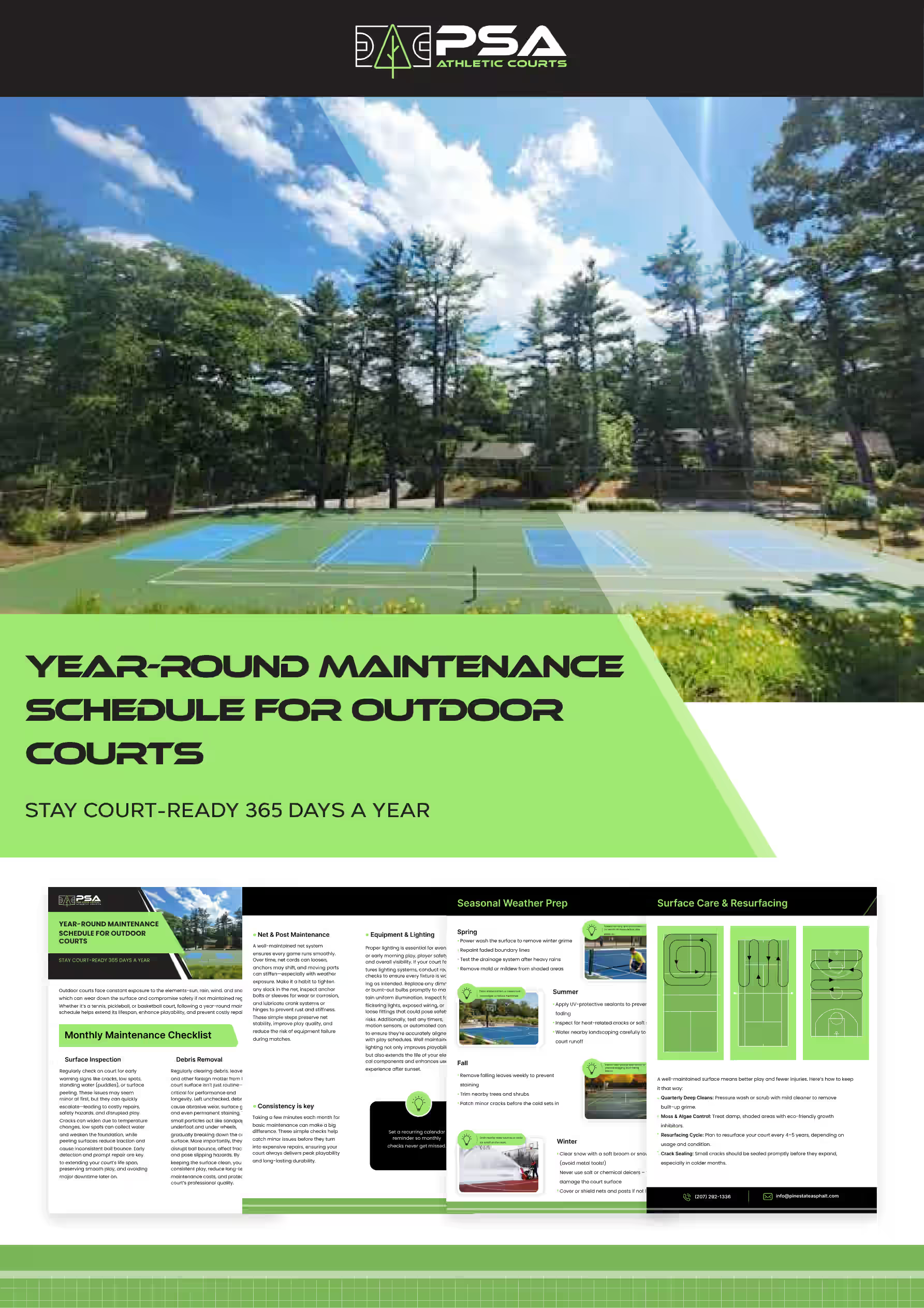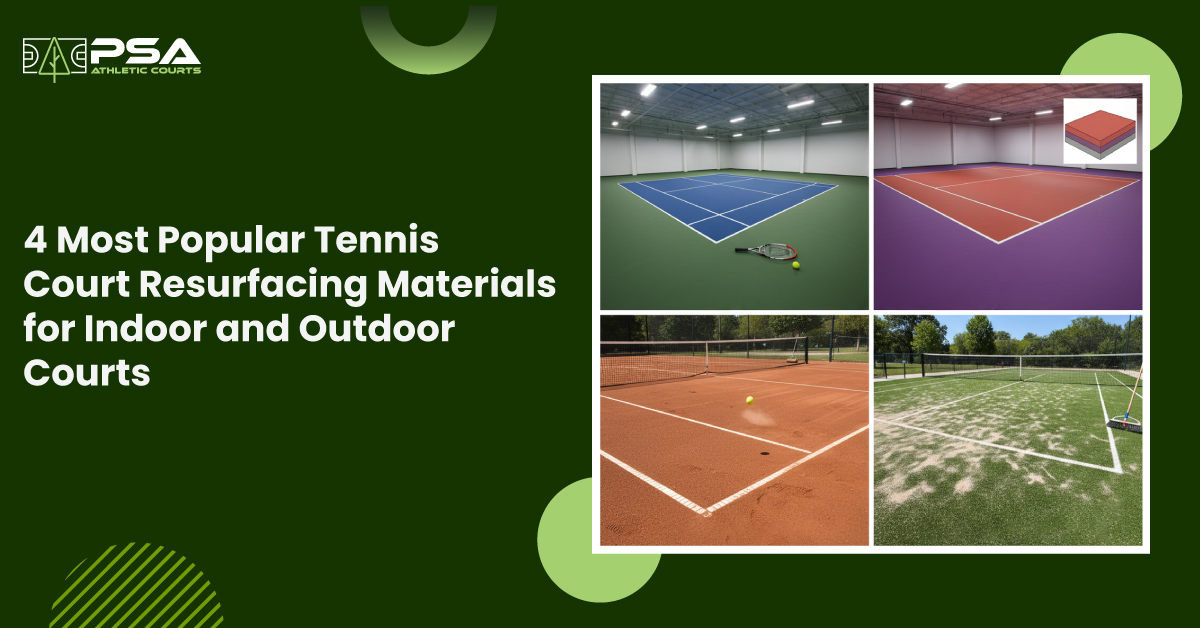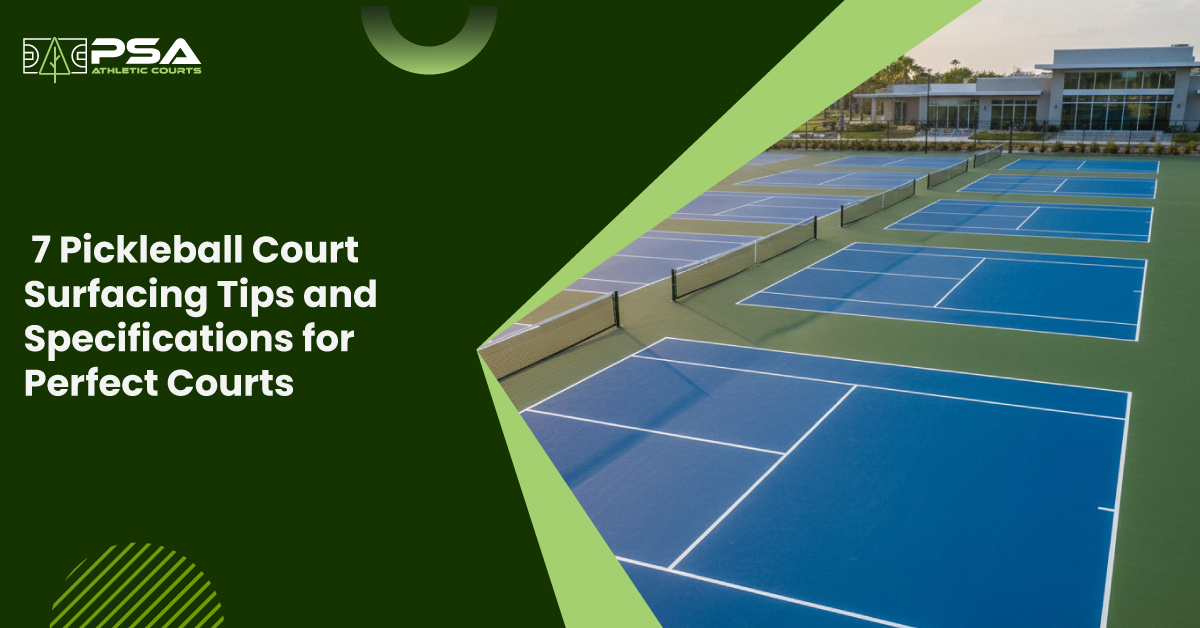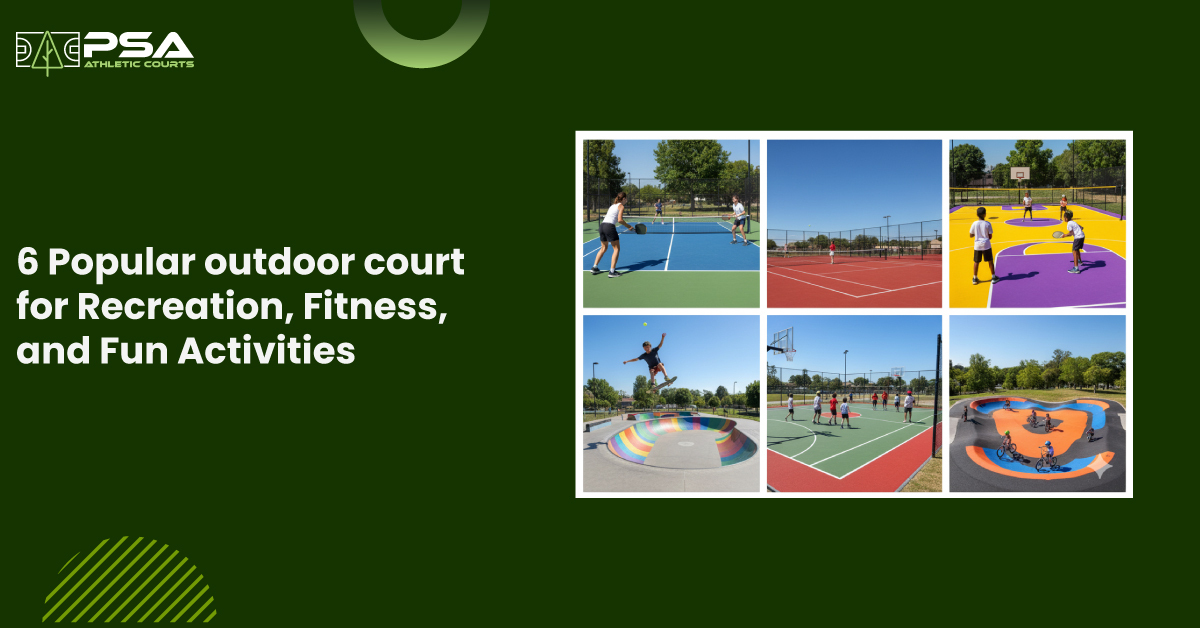Imagine stepping onto a new tennis court, the smooth, vibrant finish and responsive court surface is a total gamechanger for your play. This surface beneath your feet doesn’t just look good, it shapes every bit of your serve, volley, and rally. However, over time, even the best courts wear down, and that’s when resurfacing brings back the vitality.
But here’s the key, not all court resurfacing materials are the same. From durable outdoor finishes to cushioned indoor tennis court options, each surface offers its own performance benefits.
In this guide by Pine State Courts, we’ll highlight the four most popular tennis court resurfacing materials used across the U.S. and why choosing the right one can make all the difference.
Why Choosing the Right Material Matters
There’s a plethora of options for resurfacing materials, choosing the right one thus requires an understanding of its durability, the playing conditions it offers, and its cost. Here’s why choosing the right material for tennis court resurfacing matters so much:
It impacts the ball bounce and traction
From the low bounce of the grass courts to the high bounce of the clay court, each court offers a unique ball bounce. This along with the varied traction of court material affect how well the player performs on the court.
It protects players from injury
The choice of surface material also impacts the player's safety with its shock absorption and slip resistant properties.
It affects the life of the court
The durability of the court is also dependent on its surface with materials like concrete being the most durable up to 20 years and grass having a durability of 3-8 years.
It determines the maintenance regime of the court
The frequency of maintenance procedures is determined by the type of court material. While the grass and clay courts are high maintenance, surfaces like acrylic are preferred for their low maintenance needs.
It influences the resurfacing cost
A major contributor to the resurfacing cost is the type of surface material with the clay courts costing comparatively lesser than the other surface materials.
Read our 101 guide on tennis court resurfacing for a basic introduction to what resurfacing is and how it is done.
4 Most Popular Tennis Court Resurfacing Materials
Now that you know why the type of surface matters for resurfacing, let’s uncover what options are available when it comes to the court materials. The four most popular types of tennis court resurfacing materials, are:
1. Clay Courts
Clay courts are made of crushed stones or bricks with a top fine layer of clay. This court is quite tricky to play with its slow playing surface with a high bounce. Despite this Rafeal Nadal, hailed as the “King of Clay” boasts of a record-breaking 112 wins against 4 losses on the clay court.
Let’s now take a look at what characteristics define a clay court:
- It offers slow play with a high bounce, leading to a favorable advantage to topspin players.
- Its smooth and soft surface reduces the impact on the player's joints.
- It is perfect for long rallies that demand great endurance and strategic gameplay.
- It requires consistent maintenance in terms of watering and drying the court.
- Two common clay courts are the red clay courts (the French Open) and green clay courts (Har-Tru courts).
2. Grass Courts
The grass courts are one of the oldest playing surfaces, it is where the old name of the sport “Lawn Tennis” originated from. The famous grand slam, Wimbledon, is the only one played on a grass court.
From its fast pace to unpredictable nature, the common characteristics of the grass court include:
- It offers quick play along with strong serves and volleying.
- Offers fast and low ball bounce due to the soft surface.
- It is quite unpredictable as compared to the hard courts.
- The players often slip on the grass due to moistures, this risks their safety on the court.
- Two most commonly used grass for building tennis courts include, Ryegrass for the cooler climate and Bermuda grass for warmer climate.
3. Asphalt/Concrete with Acrylic Coating
The most common court material used globally and in the U.S. (including the U.S. Open) is the hard court. This surface material offers a balanced bounce and traction to the players. It generally consists of a concrete or asphalt that is topped with acrylic coating which adds to the aesthetics.
The common characteristics of hard courts are:
- Offers consistent ball bounce and reliable footing, ideal for a wide range of playing styles.
- Offers medium-to-fast pace play.
- Safe for the player's joints with its cushioning that protects the player’s joints.
- The amount of sand used to build it affects the speed and height of the ball bounce.
- Requires less day-to-day maintenance along with its great durability.
4. Synthetic or Modular Tiles
Another surfacing option that’s gained attention in recent years is synthetic or modular tile systems. These tiles are typically made of polypropylene and designed for quick installation, often as a DIY setup.
The characteristics of this court material include:
- Simple installation process, often marketed as a DIY-friendly option.
- Performs best in indoor or mild-climate settings.
- In colder regions like Maine, freeze-thaw cycles can cause shifting or uneven surfaces over time.
- While they promote quick drainage, they can’t match the solid, consistent play feel of a properly surfaced asphalt or concrete base.
- Low maintenance and customizable, but limited in long-term durability and performance.
For outdoor athletic courts exposed to Maine’s seasonal changes, we typically recommend acrylic surfacing systems for better longevity, play quality, and appearance.
Comparing Materials: Indoor vs. Outdoor
From the above discussion, it is quite clear that each court surface offers its benefits for the player’s performance. But with the different options available, it becomes quite difficult to choose one for indoor tennis courts and outdoor tennis courts.
Here’s a tabulated list to help you with this decision:

Factors to Consider Before Resurfacing
In addition to the type of the surface material there is a lot to consider before starting with the tennis court resurfacing project. Here’s a list of factors that you should look out for:
The extent of damages
How damaged your court is, decides the next course of action and how much the repairs will cost you.
Drainage issues
Any drainage issues will require the tennis court builder to level the court by filling in the low spots and creating a correct slope for water runoff.
Climatic conditions
Resurfacing is usually done at 50 degrees as it is the minimum temperature for bonding asphalt or acrylic courts and their curing.
Size of the court
The size of the court whether it’s a professional court or a customized backyard tennis court also affects the resurfacing, in terms of the materials required and the cost of labor.
The resurfacing cost
Budget planning is another important prerequisite to start the resurfacing project. The tennis court resurfacing cost depends on the court surface, the damage to the court, and the labor cost.
Maintenance Tips for Each Tennis Court Resurfacing Material
It is not just the tennis court resurfacing that is integral to the maintenance of the court, but regular cleaning and addressing to the court issues promptly is important too. This helps to keep the court in its best shape for a long time and increases the time between two subsequent resurfacing procedures.
So, let’s dive into the maintenance tips for each of the four tennis court resurfacing materials:
Grass courts
- Regular irrigation and fertilization to keep the grass healthy.
- Regular mowing to maintain the grass’s height, generally between 8mm to 10mm.
- Reseeding to fix any bald patches on the court.
- Pest and weed control to prevent the court from damage.
Clay courts
- Regular sweeping to remove debris.
- Routine watering (early morning or evening) to prevent the clay from drying out and hardening.
- Roll the court to keep it firm and compact.
- Check the court surface for any irregularities and even out low patches with a trovel/broom.
Asphalt/ Acrylic hard courts
- Regular sweeping of the court to remove any debris or organic matter.
- Removing standing water with a squeegee after a shower of rain.
- Clear any spills or organic growth (moss or algae) up promptly.
- Pressure-wash the court annually to remove built-up grime.
Modular tiles
- Regularly sweep and wash the court to remove dirt and debris.
- Remove any stains or spills immediately to prevent staining.
- Use a squeegee to remove the water accumulated on the court.
- Small areas can be repaired by changing out specific tiles.
Takeaway
Resurfacing your tennis court isn’t just about enhancing its looks, it's also about improving the play, safety, and longevity of the court. From the speed of grass, and durability of acrylic, to the strategic gameplay of clay, each court surface offers a unique playing experience. Choosing the right one thus depends on how the court will be used and what kind of gameplay you desire.
With the right material and regular care, your court will stay safe, high-performing, and ready for every match. At Pine State Courts, we help you achieve just that with our tennis court resurfacing and maintenance solutions along with our tennis court designing services. Connect with us to bring life to your court and enhance its longevity.
Frequently Asked Questions
1. Are clay or grass courts still popular resurfacing choices?
Clay courts are still a popular resurfacing choice for private courts or players who love a slower game with high spin. Grass courts however are pretty rare these days because of their high maintenance.
2. Which resurfacing material is best for outdoor courts?
The best resurfacing material for outdoor courts depends on whether you desire durability, safety, or cost-effectiveness. Amongst the different options, asphalt courts bring durability, good traction, and budget-friendliness, topping it off with an acrylic cushioning adds to the vibrance and safe playability of the court.
3. What is the cheapest way to resurface a tennis court?
The cheapest way to resurface a tennis court involves fixing the minor cracks and topping it with an acrylic coating without any special features.
4. What is the best surface for a tennis court at home?
The best surface for a tennis court at home is an acrylic hard court as it offers great traction and good ball bounce for player performance. It is a cost-effective and durable, long term investment.
5. What is not a popular surface for a tennis court?
Wood is not a popular surface for a tennis court and is used very rarely for indoor tennis courts. Some popular surfaces for tennis include grass, acrylic hard courts, clay, and modular tiles.
DOWNLOAD OuR
FREE GUIDE
Stay on top of your court maintenance all year. Whether it's rain, snow, summer, or fall - we've got you covered with this complete guide.
Get a complete month-by-month breakdown to keep your outdoor courts safe, clean, and game-ready.
